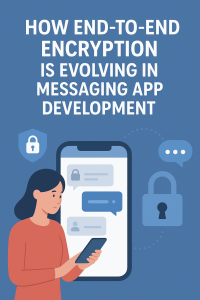
In an age where digital communication dominates every aspect of personal and professional life, the demand for secure messaging applications has skyrocketed. From casual chats to confidential business conversations, users expect privacy and protection. This is where end-to-end encryption (E2EE) comes into play—ensuring that messages can only be read by the sender and recipient, not by hackers, government agencies, or even the app provider itself.
However, as technology evolves, so does encryption. The concept that once defined privacy in apps like WhatsApp, Signal, and Telegram is now undergoing a remarkable transformation to address new challenges and expectations in modern messaging ecosystems.
What is End-to-End Encryption?
End-to-end encryption is a security framework that ensures data shared between two users remains private and unreadable to anyone else. When a user sends a message, it is encrypted on their device and can only be decrypted by the intended recipient’s device.
This process uses cryptographic keys — one public and one private — to encode and decode messages. Even if an attacker intercepts the data while it travels across servers, it remains unreadable without the correct decryption key.
In simple terms, E2EE guarantees confidentiality, authenticity, and integrity in digital communication — making it a core feature of any privacy-focused messaging app.
The Evolution of End-to-End Encryption
1. From Basic Encryption to Full-Scale Privacy
In the early days of messaging apps, encryption was often limited to data transmission. Messages were encrypted while being sent but decrypted and stored in plain text on company servers. This made them vulnerable to breaches.
With increasing privacy concerns and several high-profile data leaks, developers shifted to full-scale end-to-end encryption—meaning even service providers cannot read or store user messages. This evolution marked a turning point in messaging app development, making privacy the default, not an optional feature.
2. Perfect Forward Secrecy (PFS)
One of the major advancements in E2EE technology is Perfect Forward Secrecy. This method creates a unique encryption key for every session or message, ensuring that even if one key is compromised, previous and future messages remain secure.
Apps like Signal popularized this approach, setting a new standard in secure communication. Today, many leading messaging platforms integrate PFS into their protocols to maintain higher security resilience.
3. Quantum-Resistant Encryption
The rise of quantum computing introduces a new challenge: quantum computers can potentially break traditional encryption algorithms. To counter this, developers are now experimenting with quantum-resistant cryptography, which uses mathematical problems even quantum computers cannot easily solve.
Future-proofing messaging apps with quantum-safe algorithms is becoming a priority, especially for enterprises and governments relying on secure communication channels.
4. Decentralized and Zero-Knowledge Architectures
The latest evolution in end-to-end encryption involves decentralized encryption models and zero-knowledge systems. In these models, user data isn’t stored in centralized servers that could be hacked. Instead, encryption keys are generated and stored only on user devices.
This ensures that no third party—including app providers—has access to message content. Platforms like Matrix and Session Messenger are pioneering this shift toward fully decentralized, privacy-first communication.
5. Multi-Device Synchronization with E2EE
Traditionally, E2EE made it difficult for users to sync messages across multiple devices. However, new protocols such as Signal’s multi-device encryption and WhatsApp’s multi-device beta are solving this challenge.
By securely replicating encrypted messages using additional cryptographic layers, users can now enjoy the convenience of multi-device messaging without compromising privacy.
Challenges in Implementing End-to-End Encryption
While end-to-end encryption provides unmatched privacy, it comes with its own technical and ethical challenges:
a. Balancing Privacy and Law Enforcement Needs
Governments across the globe argue that E2EE can be misused by criminals to hide illegal activities. They advocate for “backdoors” that allow law enforcement to access data when needed. However, introducing such backdoors would compromise the privacy of all users. This ongoing debate continues to shape encryption policies and standards worldwide.
b. Performance and Scalability
Implementing robust encryption algorithms can impact app performance, especially in large-scale or resource-constrained environments. Developers must find ways to optimize encryption without slowing down the user experience — a challenge that any Messaging App Development Company must address when building secure and responsive platforms.
c. Usability and User Education
End-to-end encryption can be complex for non-technical users. Many don’t fully understand what it means or how to verify encryption keys. Simplifying user interfaces and educating users on privacy features are key steps toward making E2EE accessible to everyone.
The Role of AI and Automation in Modern Encryption
Artificial Intelligence is increasingly playing a role in encryption management. AI-driven algorithms can detect anomalies, prevent unauthorized access, and automate key management processes. For instance, machine learning models can identify patterns of suspicious login attempts or message delivery irregularities, adding another layer of proactive security.
Moreover, AI is helping optimize encryption efficiency—reducing computation time without sacrificing security strength. This makes E2EE more scalable for modern messaging ecosystems handling millions of messages per second.
Why E2EE Matters for Businesses and Users
As cyber threats become more advanced, consumers are demanding greater transparency and control over their data. Messaging platforms that offer true end-to-end encryption not only protect users but also build trust—a crucial differentiator in today’s competitive app market.
Businesses seeking Messaging App Development Services are increasingly prioritizing E2EE integration from day one. Beyond compliance and privacy, encryption also enhances brand credibility, helping apps stand out among privacy-conscious users.
Understanding the Cost and Complexity
Implementing E2EE is not a one-size-fits-all process. Factors such as the type of encryption algorithm, app architecture, user volume, and desired features can influence overall Cost. While integrating E2EE adds complexity and initial expense, it’s an investment that pays long-term dividends by reducing data breach risks and ensuring user trust.
The Future of End-to-End Encryption
The next phase of E2EE evolution will likely focus on:
Post-quantum cryptography for long-term security
Seamless synchronization across devices
AI-driven adaptive encryption systems
User-friendly verification methods like biometric-based key validation
These advancements will make encryption not just a feature but a foundation for next-generation communication apps.
Conclusion
End-to-end encryption has come a long way from being a niche feature to becoming a cornerstone of secure communication. As cyber threats evolve, so must the technologies that protect users. For developers and businesses alike, keeping up with these advancements is crucial for building trustworthy and future-ready messaging platforms.
Incorporating advanced encryption mechanisms from the start isn’t just a technical choice—it’s a commitment to user privacy, safety, and transparency in a hyperconnected world.
 :
https://in.pinterest.com/devtechnosys/
:
https://in.pinterest.com/devtechnosys/
